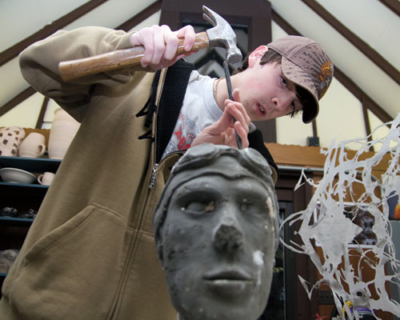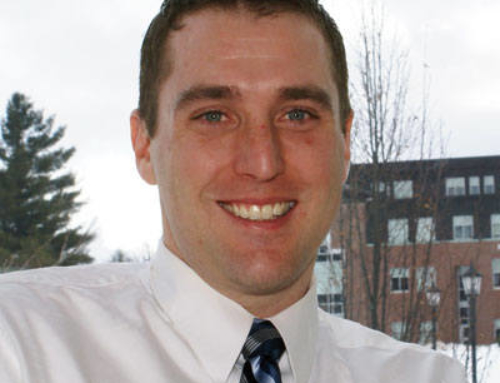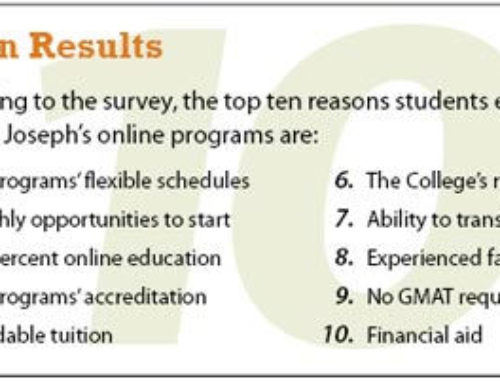 The ability to tap into the powers of the left and right brain is increasingly becoming a useful tool for employees in today’s market.
The ability to tap into the powers of the left and right brain is increasingly becoming a useful tool for employees in today’s market.
In the Stone Chapel, tucked behind Mercy Hall, freshman Nate Winter and Scott Fuller, chair of the Art Department, look over Nate’s most recent series of pottery work. Winter points out the band of blue that wraps around each piece. “This is the chemical cobalt mixed with the slip,” he says. “It’s applied by dripping it onto the clay.”
Winter’s only worked with clay for a couple months at this point, but he’s always sought a creative outlet for his hands – “anything I can get my hands on and manipulate to make something beautiful.” As a double major in business and fine arts, he says the two fields complement each other.
His enthusiasm for his creative work is meeting the reality of having to find a way to support himself after graduation – but not at the sacrifice of his creative endeavors. “I’d like my music and my art to be my life, but it’s not just about being an artist. It’s about how you present and market yourself. Learning those skills is very important.”
Winter represents a trend of coupling the creative mind with business pursuits, and there’s good reason for it.
What Winter is doing is recognized as an important step for a successful career. Lisa Bodell, CEO of futurethink, a research and training firm for businesses, wrote in an article for CNN that “The best employees of the future will excel at creative problem solving and different ways of thinking – synthesizing seemingly diverse things together for better solutions….” Winter’s understanding of the chemical processes behind the colors on his pottery will make him creative in producing his work. What he learns from his business classes will help him promote and sell what he creates in the studio – and he can combine both of these skills to meet an employer’s specific needs.
Professor Fuller looks at teaching art as a process of critical evaluation that can be applied to a myriad of different fields. “You get this really intense boot camp training in how to be self-critical,” he says, “to take a form and pick it apart, deconstruct it and make it into a form that communicates better. It doesn’t matter if you want to be an artist. You’re going to be a critical thinker and a critical problem solver.”
To prove this theory, Fuller’s collaborated with nursing professor Debra Kramlich to give presentations to nursing students. “When we analyze something visually, there’s a set of parameters and rules for how we look at it and break it down. A nurse has to examine a patient and figure out what’s going on. They’re making deconstructive observations.” Compare this to the process of creating or analyzing art, and “the processes are fundamentally connected,” says Fuller.
Andrew Mockler ’12 studied fine arts with a concentration in graphic design. He’s a freelance designer through his company A. Mockler Design, and he works for a Portland, Maine, company designing the roof components for insulation in commercial buildings. He also has to plan the materials to be used and the estimated cost.
“In both of my endeavors creativity is a key component,” says Mockler. Interestingly, it’s in his freelance design work, he says, that requires the most business sense.
He started A. Mockler Design as a junior at Saint Joseph’s, and he continues the work now. It’s a mix of business and creativity. “While I do have some clients that give their full trust and let me create something that will work for them, I also have people that know exactly what they want. So, sometimes it’s more of a compromise, designing something that works visually and also satisfies what they want.”
In this sense, Mockler’s work is as much about being creative as it is about being loyal to customer service and expectations, a point that he says might be inseparable. “I don’t know that there really is a difference between being creative and being business savvy. …Whether you’re running a successful business or working as a graphic designer, you need to have the same mindset. In order to be successful in business you need to find a way to reach your target audience, sell them your goods or service, and keep them as a repeat customer – and do all of that better than your competition. If you’re not creative with your methods and find original ways to stay ahead of your competition, then you’ll never be at the top of your field.”
A major part of this success is listening to the desires of your customer or, as Scott Fuller called it in regards to art, parameters.
Sophomore Yu Ping Hu is a fine arts and chemistry student who’s taken her painting outside of the College. Working with the Children’s Museum & Theatre of Maine in Portland, she’s painted a stage set for them using their standards.
“Art professor Chris Sullivan sent me the play’s script, and then I made sketches,” Hu says. “I talked to the director to find out what she wanted and what worked for her. She gave me her ideas, and I incorporated those into mine. It’s more like a job than something personal, but I still had some freedom with my painting. It’s fitting my ideas into theirs.”
Hu’s reconciled the fact that she can maintain her creative identity while still satisfying the parameters set by clients. “You have to think about what you’re making and the audience’s reactions. That’s OK, because that’s how the world works. If you show your work in a museum, that’s different. But if you’re working with someone else, you have to work with them – not just live in your box.”
Fuller looks at our successes around the world and sees the integral role creativity had in them. “Everyone has the capacity to learn some new skill and apply creative problem solving to it,” he says. “It’s essential to the evolution of humanity. If we didn’t have creative thinking, we wouldn’t have the industries and cities we take advantage of today.”
by David Svenson


